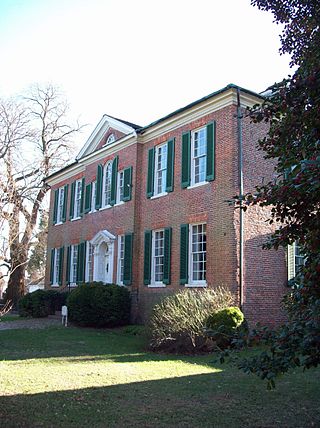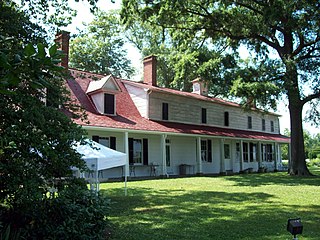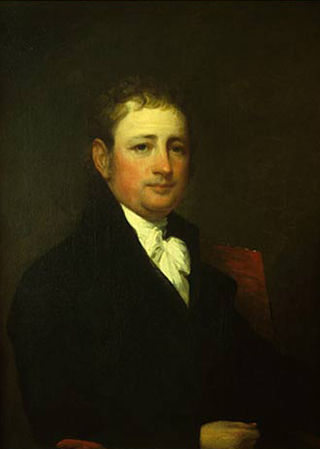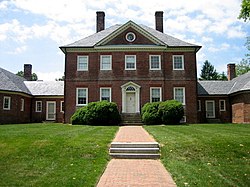
Prince George's County is located in the U.S. state of Maryland bordering the eastern portion of Washington, D.C. As of the 2020 U.S. census, the population was 967,201, making it the second-most populous county in Maryland, behind neighboring Montgomery County. The 2020 census counted an increase of nearly 104,000 in the previous ten years. Its county seat is Upper Marlboro. It is the largest and the second most affluent African American-majority county in the United States, with five of its communities identified in a 2015 top ten list.

Laurel is a city in Maryland, United States, located midway between Washington, D.C. and Baltimore on the banks of the Patuxent River. While the city limits are entirely in northern Prince George's County, outlying developments extend into Anne Arundel, Montgomery and Howard counties. Founded as a mill town in the early 19th century, Laurel expanded local industry and was later able to become an early commuter town for Washington and Baltimore workers following the arrival of the Baltimore and Ohio Railroad in 1835. Largely residential today, the city maintains a historic district centered on its Main Street, highlighting its industrial past.

The Baltimore–Washington Parkway is a limited-access highway in the U.S. state of Maryland, running southwest from Baltimore to Washington, D.C. The road begins at an interchange with U.S. Route 50 (US 50) near Cheverly in Prince George's County at the Washington, D.C. border, and continues northeast as a parkway maintained by the National Park Service (NPS) to MD 175 near Fort Meade, serving many federal institutions. This portion of the parkway is dedicated to Gladys Noon Spellman, a representative of Maryland's 5th congressional district, and has the unsigned Maryland Route 295 (MD 295) designation. Commercial vehicles, including trucks, are prohibited within this stretch. This section is administered by the NPS's Greenbelt Park unit. After leaving park service boundaries the highway is maintained by the state and signed with the MD 295 designation. This section of the parkway passes near Baltimore–Washington International Thurgood Marshall Airport.
Montpelier, Prince George's County, Maryland, United States, is a suburban community outside the corporate boundaries of Laurel. Located near the Baltimore–Washington Parkway, it was built in the 1960s and early 1970s by Levitt & Sons. There are four models of houses in the Levitt style, with mirror images giving eight different floor plans.

Maryland Route 197 is a state highway in the U.S. state of Maryland. Known for most of its length as Laurel Bowie Road, the state highway runs 14.64 miles (23.56 km) from U.S. Route 301 in Bowie north to MD 198 in Laurel. MD 197 serves as the main connection between Bowie and Laurel in northern Prince George's County. The highway also provides access to Patuxent Wildlife Research Center and Bowie State University. MD 197 also connects US 50 in Bowie and the Baltimore–Washington Parkway in South Laurel with the Bowie State MARC station.

Oatlands Historic House and Gardens is an estate located in Leesburg, Virginia, United States. Oatlands is operated by the National Trust for Historic Preservation and is listed on the National Register of Historic Places as a National Historic Landmark. The Oatlands property is composed of the main mansion and 415 acres of farmland and gardens. The house is judged one of the finest Federal period country estate houses in the nation.

Laurel is a historic passenger rail station on the MARC Camden Line in Laurel, Maryland, between the District of Columbia's Washington Union Station and Baltimore's Camden Station.

The William Paca House is an 18th-century Georgian mansion in Annapolis, Maryland, United States. Founding Father William Paca was a signatory of the Declaration of Independence and a three-term Governor of Maryland. The house was built between 1763 and 1765 and its architecture was largely designed by Paca himself. The 2-acre (8,100 m2) walled garden, which includes a two-story summer house, has been restored to its original state.

His Lordship's Kindness, also known as Poplar Hill, is a historic plantation estate on Woodyard Road east of Clinton, Maryland. It was built in the 1780s for Prince George's County planter Robert Darnall. The five-part Georgian mansion retains a number of subsidiary buildings including a slave's hospital and a dovecote. The property is now operated as a museum by a local nonprofit preservation group. It was designated a National Historic Landmark in 1970.

Riversdale, is a five-part, large-scale late Georgian mansion with superior Federal interior, built between 1801 and 1807. Also known as Baltimore House, Calvert Mansion or Riversdale Mansion, it is located at 4811 Riverdale Road in Riverdale Park, Maryland, and is open to the public as a museum.

Sotterley Plantation is a historic landmark plantation house located at 44300 Sotterley Lane in Hollywood, St. Mary's County, Maryland, USA. It is a long 1+1⁄2-story, nine-bay frame building, covered with wide, beaded clapboard siding and wood shingle roof, overlooking the Patuxent River. Also on the property are a sawn-log slave quarters of c. 1830, an 18th-century brick warehouse, and an early-19th-century brick meat house. Farm buildings include an early-19th-century corn crib and an array of barns and work buildings from the early 20th century. Opened to the public in 1961, it was once the home of George Plater (1735–1792), the sixth Governor of Maryland, and Herbert L. Satterlee (1863–1947), a New York business lawyer and son-in-law of J.P. Morgan.

Snow Hill is a manor house located south of Laurel, Maryland, off Maryland Route 197, in Prince George's County. Built between 1799 and 1801, the 1+1⁄2-story brick house is rectangular, with a gambrel roof, interior end chimneys, and shed dormers. It has a center entrance with transom and a small gabled porch. A central hall plan was used, with elaborate interior and corner cupboards. The original south wing was removed and rebuilt, and the home restored in 1940. The Late Georgian style house was the home of Samuel Snowden, part owner of extensive family ironworks, inherited from his father Richard Snowden. and is now owned and operated by the Maryland-National Capital Park and Planning Commission as a rental facility.

Snowden Hall is a historic house located on the grounds of the Patuxent Wildlife Research Center, outside Laurel in Prince George's County, Maryland, United States. It stands on open rolling ground approximately 3⁄4-mile west of the Patuxent River.

Oxon Hill Manor is a neo-Georgian house of 49 rooms, located at Forest Heights, Prince George's County, Maryland. It was designed in 1928 for Sumner Welles (1892-1961) by the Washington architect, Jules Henri de Sibour (1872-1938). It was built in 1929, and consists of a two-story main block of Flemish bond brick and a northern wing. Also on the property are two outbuildings contemporary with the house; a five-car garage and attached manager's quarters and greenhouse, and a stable. There are also formal gardens on the grounds.

Mount Harmon is an historic home, located at Earleville, Cecil County, Maryland, United States. It was listed on the National Register of Historic Places in 1974, and is currently open to the public.

George Calvert, was a plantation owner and slaveholder in late eighteenth- and early nineteenth-century Maryland. His plantation house, Riversdale plantation, also known as the Calvert Mansion, is a five-part, large-scale late Georgian mansion with superior Federal interior, built between 1801 and 1807, and was designated a National Historic Landmark in 1997. Calvert's wife, the Belgian-born heiress Rosalie Stier Calvert, was an indefatigable correspondent whose letters, titled Mistress of Riversdale, The Plantation Letters of Rosalie Stier Calvert, was published by the Johns Hopkins University Press in 1991. The letters range in date from 1795 to 1821, and illuminate the life of the Calverts' plantation household during the events leading up to and during the War of 1812.
The Laurel Mill was a multi-use mill located along the Patuxent River in Laurel, Maryland. Built by Nicholas Snowden on the site of an earlier grist mill, Laurel Mill operated intermittently between 1811 and 1929, manufacturing flour, cloth, cotton duck and other cotton products, and window shades. Between 1835 and 1851 the mill was operated by Horace Capron, who had married into the Snowden family, and the Patuxent Manufacturing Company, who also established the town of Laurel Factory, which was incorporated as Laurel in 1870.
Montpelier Mansion, sometimes referred to as "Montpelier I", was a house in western Laurel, Maryland, now more closely associated with Fulton, Maryland within Howard County, Maryland, United States. The Georgian style building was built circa 1740 and demolished following a 1994 historic survey with addendum and photos dating as late as August 1995.
The Duvall Farm was a historic farm located in North Laurel, Howard County, Maryland, now the site of Coastal Sunbelt Produce.
Oaklands or Contee was a slave plantation owned by the Snowden family, and remains as a historic home surrounded by residential development.
























